Software Transactional Memory Techniques » książka
Software Transactional Memory Techniques
ISBN-13: 9783659388262 / Angielski / Miękka / 2013 / 80 str.
The advent of multicore processors has put the performance of traditional parallel programming techniques in question. The traditional lock-based parallel programming techniques are error prone and suffer from various problems such as deadlocks, live-locks, priority inversion etc. In the last one and half decade, a considerable amount of the research has been carried out to achieve the synchronization among the parallel applications without using locking. One of most promising technique which has come out as a result of this research work is Transactional Memory (TM). Transactional Memory system commits the data in atomic code sequences called the transaction. In order to understand the design and implementation trade-offs of different implementations of the Software Transactional Memory, a comprehensive comparative study is required. Although some comparative studies have been carried out in the past, they were very focused in their scope and covered only few STM implementations. In this report, a qualitative literature survey is conducted and the state of the art in Software Transactional Memory is presented, covering prominent approaches to date.
The advent of multicore processors has put the performance of traditional parallel programming techniques in question. The traditional lock-based parallel programming techniques are error prone and suffer from various problems such as deadlocks, live-locks, priority inversion etc. In the last one and half decade, a considerable amount of the research has been carried out to achieve the synchronization among the parallel applications without using locking. One of most promising technique which has come out as a result of this research work is Transactional Memory (TM). Transactional Memory system commits the data in atomic code sequences called the transaction. In order to understand the design and implementation trade-offs of different implementations of the Software Transactional Memory, a comprehensive comparative study is required. Although some comparative studies have been carried out in the past, they were very focused in their scope and covered only few STM implementations. In this report, a qualitative literature survey is conducted and the state of the art in Software Transactional Memory is presented, covering prominent approaches to date.











